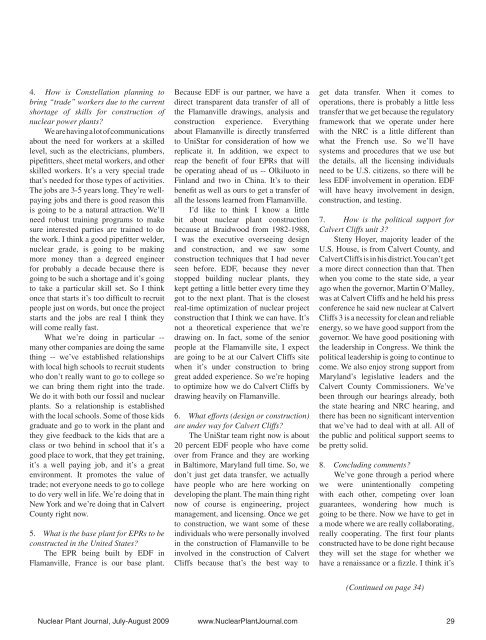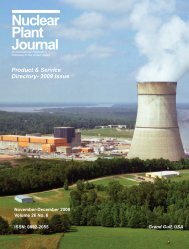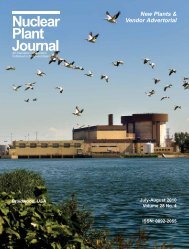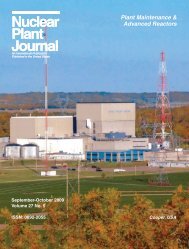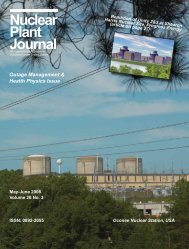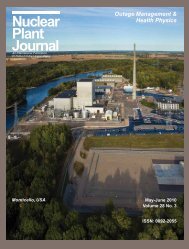Nuclear Plant Journal Nuclear Plant Journal - Digital Versions
Nuclear Plant Journal Nuclear Plant Journal - Digital Versions
Nuclear Plant Journal Nuclear Plant Journal - Digital Versions
You also want an ePaper? Increase the reach of your titles
YUMPU automatically turns print PDFs into web optimized ePapers that Google loves.
4. How is Constellation planning to<br />
bring “trade” workers due to the current<br />
shortage of skills for construction of<br />
nuclear power plants?<br />
We are having a lot of communications<br />
about the need for workers at a skilled<br />
level, such as the electricians, plumbers,<br />
pipefitters, sheet metal workers, and other<br />
skilled workers. It’s a very special trade<br />
that’s needed for those types of activities.<br />
The jobs are 3-5 years long. They’re wellpaying<br />
jobs and there is good reason this<br />
is going to be a natural attraction. We’ll<br />
need robust training programs to make<br />
sure interested parties are trained to do<br />
the work. I think a good pipefitter welder,<br />
nuclear grade, is going to be making<br />
more money than a degreed engineer<br />
for probably a decade because there is<br />
going to be such a shortage and it’s going<br />
to take a particular skill set. So I think<br />
once that starts it’s too difficult to recruit<br />
people just on words, but once the project<br />
starts and the jobs are real I think they<br />
will come really fast.<br />
What we’re doing in particular --<br />
many other companies are doing the same<br />
thing -- we’ve established relationships<br />
with local high schools to recruit students<br />
who don’t really want to go to college so<br />
we can bring them right into the trade.<br />
We do it with both our fossil and nuclear<br />
plants. So a relationship is established<br />
with the local schools. Some of those kids<br />
graduate and go to work in the plant and<br />
they give feedback to the kids that are a<br />
class or two behind in school that it’s a<br />
good place to work, that they get training,<br />
it’s a well paying job, and it’s a great<br />
environment. It promotes the value of<br />
trade; not everyone needs to go to college<br />
to do very well in life. We’re doing that in<br />
New York and we’re doing that in Calvert<br />
County right now.<br />
5. What is the base plant for EPRs to be<br />
constructed in the United States?<br />
The EPR being built by EDF in<br />
Flamanville, France is our base plant.<br />
Because EDF is our partner, we have a<br />
direct transparent data transfer of all of<br />
the Flamanville drawings, analysis and<br />
construction experience. Everything<br />
about Flamanville is directly transferred<br />
to UniStar for consideration of how we<br />
replicate it. In addition, we expect to<br />
reap the benefit of four EPRs that will<br />
be operating ahead of us -- Olkiluoto in<br />
Finland and two in China. It’s to their<br />
benefit as well as ours to get a transfer of<br />
all the lessons learned from Flamanville.<br />
I’d like to think I know a little<br />
bit about nuclear plant construction<br />
because at Braidwood from 1982-1988,<br />
I was the executive overseeing design<br />
and construction, and we saw some<br />
construction techniques that I had never<br />
seen before. EDF, because they never<br />
stopped building nuclear plants, they<br />
kept getting a little better every time they<br />
got to the next plant. That is the closest<br />
real-time optimization of nuclear project<br />
construction that I think we can have. It’s<br />
not a theoretical experience that we’re<br />
drawing on. In fact, some of the senior<br />
people at the Flamanville site, I expect<br />
are going to be at our Calvert Cliffs site<br />
when it’s under construction to bring<br />
great added experience. So we’re hoping<br />
to optimize how we do Calvert Cliffs by<br />
drawing heavily on Flamanville.<br />
6. What efforts (design or construction)<br />
are under way for Calvert Cliffs?<br />
The UniStar team right now is about<br />
20 percent EDF people who have come<br />
over from France and they are working<br />
in Baltimore, Maryland full time. So, we<br />
don’t just get data transfer, we actually<br />
have people who are here working on<br />
developing the plant. The main thing right<br />
now of course is engineering, project<br />
management, and licensing. Once we get<br />
to construction, we want some of these<br />
individuals who were personally involved<br />
in the construction of Flamanville to be<br />
involved in the construction of Calvert<br />
Cliffs because that’s the best way to<br />
get data transfer. When it comes to<br />
operations, there is probably a little less<br />
transfer that we get because the regulatory<br />
framework that we operate under here<br />
with the NRC is a little different than<br />
what the French use. So we’ll have<br />
systems and procedures that we use but<br />
the details, all the licensing individuals<br />
need to be U.S. citizens, so there will be<br />
less EDF involvement in operation. EDF<br />
will have heavy involvement in design,<br />
construction, and testing.<br />
7. How is the political support for<br />
Calvert Cliffs unit 3?<br />
Steny Hoyer, majority leader of the<br />
U.S. House, is from Calvert County, and<br />
Calvert Cliffs is in his district. You can’t get<br />
a more direct connection than that. Then<br />
when you come to the state side, a year<br />
ago when the governor, Martin O’Malley,<br />
was at Calvert Cliffs and he held his press<br />
conference he said new nuclear at Calvert<br />
Cliffs 3 is a necessity for clean and reliable<br />
energy, so we have good support from the<br />
governor. We have good positioning with<br />
the leadership in Congress. We think the<br />
political leadership is going to continue to<br />
come. We also enjoy strong support from<br />
Maryland’s legislative leaders and the<br />
Calvert County Commissioners. We’ve<br />
been through our hearings already, both<br />
the state hearing and NRC hearing, and<br />
there has been no significant intervention<br />
that we’ve had to deal with at all. All of<br />
the public and political support seems to<br />
be pretty solid.<br />
8. Concluding comments?<br />
We’ve gone through a period where<br />
we were unintentionally competing<br />
with each other, competing over loan<br />
guarantees, wondering how much is<br />
going to be there. Now we have to get in<br />
a mode where we are really collaborating,<br />
really cooperating. The first four plants<br />
constructed have to be done right because<br />
they will set the stage for whether we<br />
have a renaissance or a fizzle. I think it’s<br />
(Continued on page 34)<br />
<strong>Nuclear</strong> <strong>Plant</strong> <strong>Journal</strong>, July-August 2009 www.<strong>Nuclear</strong><strong>Plant</strong><strong>Journal</strong>.com 29


